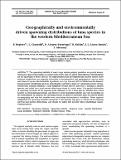Por favor, use este identificador para citar o enlazar a este item:
http://hdl.handle.net/10261/323991COMPARTIR / EXPORTAR:
 SHARE SHARE
 CORE
BASE CORE
BASE
|
|
| Visualizar otros formatos: MARC | Dublin Core | RDF | ORE | MODS | METS | DIDL | DATACITE | |

| Título: | Geographically and environmentally driven spawning distributions of tuna species in the western Mediterranean Sea |
Autor: | Reglero, Patricia CSIC ORCID; Ciannelli, Lorenzo; Álvarez-Berastegui, Diego; Balbín, Rosa; López-Jurado, José Luis; Alemany, Francisco | Palabras clave: | Pesquerías Spawning strategy Centro Oceanográfico de Baleares Spawning habitat Regional scale Spatial distribution Large predators Migratory strategry Mediterranean Tuna |
Fecha de publicación: | 2012 | Citación: | Marine Ecology-Progress Series, 463. 2012: 273-284 | Resumen: | The spawning habitats of many large marine pelagic predators are poorly known. This lack of knowledge hampers conservation efforts that are aimed at identifying critical habitats for the spawning of these species. We hypothesized that phylogenetically related species show different adaptations and respond differently to environmental and geographical cues for when and where to spawn. We tested this hypothesis on a 5 yr data set (2001 to 2005) from the Balearic Islands region (Mediterranean Sea), targeting the early larval stage of 3 abundant species of tuna: bluefin tuna Thunnus thynnus, a large migratory oceanic species; albacore T. alalunga, a smaller species; and bullet tuna Auxis rochei, often found closer to coastal areas. The spatial distribution of spawning locations at the regional scale differed for the 3 tuna species. Bluefin tuna relied heavily on environmental signals, and therefore their spawning habitats can vary depending on the environment. In contrast, the spawning habitat of albacore and bullet tuna was driven mostly by geography and was less variable over contrasting environmental conditions. These regional adaptations for spawning habitats among the 3 tuna species may play a critical role in offspring survival and species interactions, and should be taken into account when establishing conservation practices | URI: | http://hdl.handle.net/10261/323991 | DOI: | 10.3354/meps09800 |
| Aparece en las colecciones: | (IEO) Artículos |
Ficheros en este ítem:
| Fichero | Descripción | Tamaño | Formato | |
|---|---|---|---|---|
| Reglero_etal_2012_MEPS.pdf | 2,19 MB | Adobe PDF |  Visualizar/Abrir |
CORE Recommender
SCOPUSTM
Citations
75
checked on 17-abr-2024
WEB OF SCIENCETM
Citations
72
checked on 26-feb-2024
Page view(s)
24
checked on 28-abr-2024
Download(s)
14
checked on 28-abr-2024
Google ScholarTM
Check
Altmetric
Altmetric
Este item está licenciado bajo una Licencia Creative Commons

